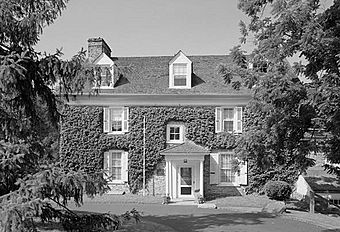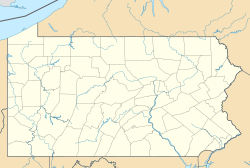Mill Grove facts for kids
|
Mill Grove
|
|

Mill Grove
|
|
| Location | Pawlings Rd., Audubon, Pennsylvania |
|---|---|
| Area | 130 acres (53 ha) |
| Built | 1762 |
| Architect | James Morgan |
| NRHP reference No. | 72001138 |
Quick facts for kids Significant dates |
|
| Added to NRHP | March 16, 1972 |
| Designated NHL | May 5, 1989 |
Mill Grove is a special historic house and large property located on Pawlings Road in Audubon, Pennsylvania. It was built in the 1760s. This place is famous because it was the first home in America for the well-known painter and naturalist John James Audubon (1785-1851). The town of Audubon is even named after him!
The property is about 130 acres (53 hectares) in size. Today, it is a museum and a place where wildlife is protected. Montgomery County takes care of it. In 1989, Mill Grove was named a National Historic Landmark, which means it's a very important historical site. The house is also the main learning center for the Pennsylvania part of the National Audubon Society. It is known as the John James Audubon Center at Mill Grove.
Contents
What is Mill Grove Like?
Mill Grove is found on the west side of the small town of Audubon. It is just north of Valley Forge National Historical Park. The property has more than 130 acres (53 hectares) of mostly woods. It sits on the south bank of the Perkiomen Creek. Pawlings Road forms its southern border.
The main house is made of stone and has two and a half stories. It faces the creek. The roof has three wooden dormer windows on each side. There are also stone chimneys inside at each end of the house. A single-story part of the building extends to one side. A porch with a gabled roof covers the main entrance.
A Home with a Long History
Early Days and the Revolution
The house was built around 1762 by a man named James Morgan. He also ran a mill and a lead mine on the property. Morgan added more to the house in 1764 or 1765. This new part was probably for guests and a bigger kitchen.
Because Mill Grove was close to Valley Forge, it was robbed during the American Revolutionary War. However, the house itself was not badly damaged.
John James Audubon's American Start
In 1789, a French sea captain named Jean Audubon bought the property. In 1803, he sent his 18-year-old son, Jean, to Mill Grove. His son soon changed his name to John James Audubon. He was supposed to manage the lead mine.
But instead of working on the mine, young Audubon fell in love with the beautiful nature around him. He spent two years here. During that time, he taught himself how to track birds by putting bands on them. He also learned how to prepare birds so he could draw them. He even got engaged to Lucy Bakewell here. He came back to Mill Grove in 1808 for their wedding.
John James Audubon was away from Mill Grove between 1805 and 1808. Another Frenchman looked after the property during that time. After his wedding, Audubon sold the property to this Frenchman.
From Family Home to Nature Center
In 1813, Samuel Wetherill bought Mill Grove. His family owned the property until 1951. His family then gave the property to Montgomery County. Since then, the county has managed it as a place to protect wildlife and as a nature center.
Exploring Mill Grove Today
Today, the Mill Grove property is 175 acres (71 hectares). It has more than five miles (8 kilometers) of walking trails. The house now has a museum inside. You can see original drawings by Audubon there. It also displays all of his major oil paintings and other items that belonged to him.
See also



